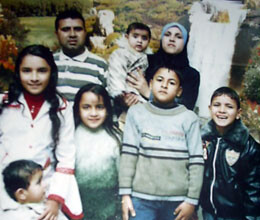Shati' refugee camp, Gaza Strip 7 January 2008

The al-Khatib family’s last family portrait with Awni. (Rami Almeghari)
Awni al-Khatib died a few days of the brain damage he suffered since 1990 when he was shot in the head by an Israeli-fired, rubber-coated steel bullet.
Awni is one of thousands of Palestinians who sustained injuries from such bullets during the first intifada that broke out in 1987.
“Awni’s state of mind has been unstable since we got married as he has always hoped for death rather than staying alive,” Ghada explains.
The young widow, in her twenties, speaks of her husband’s traits, saying was kind and tolerant, to the extent he favored his family over himself.
However, he always prayed to die sooner rather later, she recalls.
Ghada explains that Awni fainted frequently — in the street, at home and anywhere else.
“We have lost a tender and a kind-hearted husband and father, and I don’t think anything in this life can compensate us such a great loss. He had been recently insisting that we sell our house for the sake of paying back some debts. Awni was a very good father; he has always been aware, despite his fatal injury.”
Ghada concludes her talk by saying, “Abu Jehad [Awni] has simply been a living martyr.”
Awni left behind six children, including a nine-month-old daughter, who all live in a small, ill-equipped three-room home off one of the alleys of al-Shati’ refugee camp.
Abdelrahin al-Khatib says that his brother Awni was shot and wounded in the head in the Shati’ camp when he was 16 years old in 1990.
Later on, he was treated at the Israeli hospital of Tal Hashomir for a couple of months. He was moved back to Gaza when his condition stabilized, the rubber-coated steel bullet still lodged in his head.
Following the injury he suffered seizures that disrupted his daily life, and was of an unstable mood most of the time, says Mohammad.
“God has given him mercy,” believes Mohammad.
During the first Palestinian intifada, or uprising against the Israeli occupation, the Israeli army employed several means of suppressing the popular resistance, including firing rubber-coated steel bullets, disabling the bodies of thousands of stone throwers.
According to the Palestinian Wounded Society, 70,000 Palestinians were wounded between 1987 and 1993, 40 percent of them with permanent disabilities. Many suffered brain damage or had their limbs amputated.
The death of Awni al-Khatib is not the first and surely not the last of this type of injury, as there are thousands more “living martyrs.”
Rami Almeghari is currently contributor to several media outlets including the Palestine Chronicle, aljazeerah.info, IMEMC, The Electronic Intifada and Free Speech Radio News. Rami is also a former senior English translator at and editor in chief of the international press center of the Gaza-based Palestinian Information Service. He can be contacted at rami_almeghari at hotmail.com.





